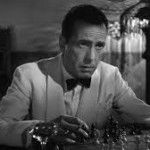Question: How do I make my opening sell my story?
 The opening of any story is crucial. A potential reader may be standing in a store aisle scanning the first few pages or reading the free sample offered on an electronic device. The situation is the same. A storyteller gets one chance to make a first impression and mustn’t squander that chance.
The opening of any story is crucial. A potential reader may be standing in a store aisle scanning the first few pages or reading the free sample offered on an electronic device. The situation is the same. A storyteller gets one chance to make a first impression and mustn’t squander that chance.
So – begin with a Dramatic Opening. That doesn’t mean you have to start out with a murder scene the way I like to do in my romantic suspense novels. Your opening can be more subtle than that. But it must be dramatic. Let me use an example from a favorite film of mine – Casablanca. Which is in my opinion one of the great romantic suspense stories of all time.
By the way – I’ll often use movies as storytelling examples. Maybe more often than I use books. I do this because I find that more of us have seen the same movies than have read the same books. And I want all of us to be able to relate to the examples I use. You also have easy reference to these examples because you can stream most of them on your computer.
Casablanca came out in 1942. Already the world was immersed in the most dramatic of times. The opening taps directly into that with a map of Europe and then Africa and Northern Africa beneath the credits. Maps meant something very significant in WWII. They ran in newspapers almost daily alongside stories of heart-stopping events. Battles – even troop movements if they could be made known. Maps were a life and death visual to a 1942 audience.
There’s also music. Exotic at first as the map moves toward North Africa. We’re headed for a world distant and different from our own. A complicated and possibly incomprehensible world. We need to be on guard and maybe even afraid. On an abrupt beat the music changes. Loud and rousing – La Marseillaise makes our hearts beat to a different tune. Even more dramatic and affecting than what we’ve already heard. And we’re not even past the credits yet.
We aren’t even at Rick’s Café Americain with Rick himself at the bar. Brow furrowed – cigarette stub smoldering – weight of a heavy wound beneath the square shoulders of his white dinner jacket. Want to see what a romantic hero – or any kind of hero – looks like? Screen this scene ASAP. Plus in the next two minutes you’ll see his inner character nailed as well.
A story’s dramatic opening has a lot of work to do. A lot of weight to carry beneath its square shoulders. This film does that in spades as clear and unmistakable as the ones on the cards the croupier turns in Rick’s gambling den. Does your story opening carry that weight as well? Why don’t you ask it if it does? Here are the 10 Crucial Questions to use in that interrogation.
1. At this moment my protagonist must be plunged into a situation where she feels as if her world is being yanked out from under her. Is that happening and how does it happen?
2. From this point on his life will never be the same again. How, specifically, will his life be changed?
3. From this moment on, my protagonist will be engaged in struggle. How specifically does that struggle begin in this opening scene?
4. This scene must begin in the middle of something dramatic already in progress. How specifically is that the case in my story?
5. I need to describe what my main character looks like. I must describe her or him via a couple of significant details rather than by interrupting the dramatic action of the scene. What specifically are those significant details?
6. This scene must at least suggest that something important is at stake for my character in this story and preferably for others too. What specifically are the dire circumstances that will result if my character fails to succeed in this story?
7. Obstacles to that success must already be evident in this scene. What specific obstacles to that success are already evident or at least hinted at in this scene?
8. My main character must make a conscious decision to act in response to the situation in this scene and that decision sets the story in motion. What specifically is that decision and how does it set the story in motion?
9. My character must be a person with whom the reader will wish to identify – motivated to act by something the reader can relate to and find sympathetic. How specifically does my character fulfill these expectations?
10. The action of the story must begin immediately in this scene. How specifically does that happen in my story?
Re-read these 10 Crucial Questions. Think about them in terms of your story. Be hardnosed with yourself and with your story as you answer each one. If your responses aren’t solid and dramatic – your story opening isn’t solid and dramatic. Make it so.
If you feel a bit overwhelmed – stream the opening of Casablanca. Take notes on how simply all of this is managed there. And be specific yet again.
While you’re doing that. “Here’s looking at you kid.”
RR
My latest story is A WRONG WAY HOME – Riverton Road Romantic Suspense Series Book #1 – Matt & Kara’s Story. Available at amazon.com/author/aliceorr. This is my 12th novel and it has a dramatic opening.
Alice Orr – www.aliceorrbooks.com